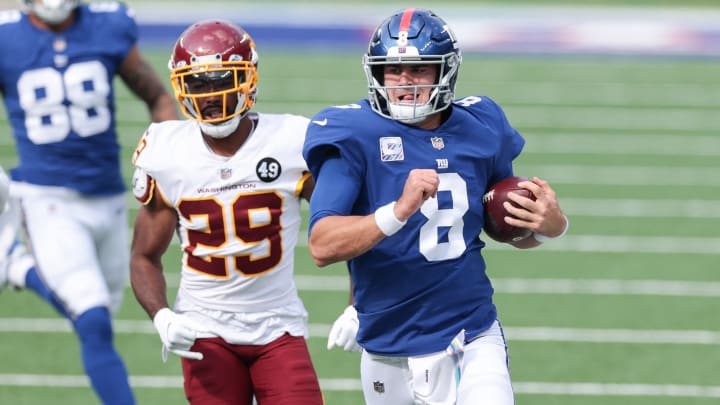5 Areas Where Daniel Jones Must Improve in 2021

Football is a team sport, so it's no wonder why New York Giants quarterback Daniel Jones remains something of an uncertain entity as he prepares for his third season.
The organization did Jones no favors by not having a solid offensive line in place ahead of Jones' promotion to the full-time starter role, but they are confident that they finally have it right after four offseasons of trying.
They also didn't do Jones any favors by throwing him into the starting lineup two games into his rookie season when his receiving corps consisted of an aging veteran (Golden Tate) and a rookie (Darius Slayton), to go along with an inconsistent performing tight end (Evan Engram).
Imagine just how much easier things might have been for Jonas as he transitioned had he had a legitimate No. 1 receiver at the start of his career?
You can also throw in the fact that Jones had to learn two different offensive systems as a pro.
In all, it's no wonder why the Giants organization has been extremely patient with Jones.
Whereas new head coaches coming into other places (Arizona, Philadelphia, Jacksonville) have seen the previous "franchise" quarterback traded away in favor of "their guy," the Giants haven't made such a move yet.
That's probably because head coach Joe Judge has undoubtedly realized that Jones has often had the deck stacked against him that has kept him from reaching his full potential.
All that said, the excuses have evaporated. Jones, ranked as Pro Football Focus' 20th-best starting quarterback (out of 32) ahead of the 2021 season, notes that, "This is the first offseason Jones will be in the same offense, which will offer more familiarity going into his third season. Jones must eliminate the boneheaded decisions and turnover-worthy plays that hold the team back."
So let's take a look at some of the things Jones can do to take that step forward that everyone thinks (or is that hopes?) he can make in Year 3.
1. Expedite his decision-making.
Jones averaged 2,71 seconds to throw the ball last year, slightly less than his career average of 2.77.
Worth noting is that Jones' 2.71 average time to throw was the same as Green Bay's Aaron Rodgers (tying both quarterbacks for 13th longest average time to throw among quarterbacks who took 50% of their team's drop backs).
But the big difference between Jones and Rodgers is Rodgers can get through his reads and, more times than not, know where the best place is to go with the ball, whereas in watching Jones play, sometimes you come away thinking that there's a bit of uncertainty in his game.
Hopefully, as he begins Year 3 in the same system, some of that hesitancy dissipates.
2) Improve his feel in the pocket.
How many times have we seen Jones standing in the pocket waiting and waiting and waiting for someone to get open only to find that the someone who gets open is a defender who has come free and crashes into him?
Quarterbacks need to be able to "sense" when a defender is approaching the sanctity of the pocket so they can either get out of the way or throw the ball away.
Jones has taken a few more hits than he probably should have thus far in his career. Improved pass protection will help, but so too will better pocket awareness.
MORE FROM GIANTS COUNTRY
Check out our 90-man roster player previews. We have a new preview dropping every day through the start of the Giants' training camp.
3) Learn to live to see another day.
Jones is a competitor who hates to lose, and if you have any doubt about that, just watch how he tries to bleed every yard possible out of a play or how he hangs in there until virtually the last split second.
This was a bone of contention with the coaching staff, who tried to impress upon Jones that it's okay to throw the ball away or come up a yard short if you have additional downs.
Previous failures to do so led to some sloppiness with ball security, especially when on the move and his not being aware of a defender closing in on him. Again, Jones got a little better at that, but he needs to eliminate that from his game.
4) Improve his accuracy
Jones finished 2020 with a 62.5% accuracy rate, up from his 61.9% rate as a rookie, but a closer look at the numbers reveals there is still much work to be done in that department, according to Pro Football Focus's 2021 Quarterback Annual.
Jones was accurate on 55.5% of his throws that hit receivers in the breadbasket. To be fair, this stat doesn't account for dropped balls, but what is factored into these stats are the percentages of overthrows, balls thrown in front of the receiver, and balls thrown behind them.
Those stats break down as follows: 5.2% of the passes were overthrown, 3.6% were thrown in front of the receiver, and 3.8% were thrown behind the receiver. Reducing those percentages would go a long way toward boosting Jones' overall accuracy rate and the offense's production.
Jones also went to his first look on 70% of his passing attempts, yet he only connected on 55.4% of those attempts.
In particular, his accuracy rate on short- and intermediate-range pass attempts (under 20 yards) fell way below the NFL average. In contrast, his accuracy on deep throws of 20+ yards (21.4%) exceeded the NFL average (14.5%).
THE "GOOD, GREAT AND UGLY" SERIES
Kelvin Benjamin | RB Devontae Booker
5) Improve his red-zone production.
Jones threw just 11 touchdowns last season, less than half of what he produced in 2019. And a big reason for that was the decline in the red zone, where he saw his passer rating drop from 99.7 in 2019 to 75.8 last year, according to Pro Football Focus's 2021 Quarterback Annual.
What's even odder about this is that in 2020, Jones had the same cast of characters as he did in 2019, the lone exception being tight end Evan Engram, who was available for the entire 2020 season, unlike the prior year. Yet, for some reason, Jones's red-zone production still declined, perhaps due to the new system.
And although he reduced his interceptions from his rookie season to Year 2 (going from 12 to 10), he threw more interceptions in the red zone in Year 2 (4.6% of his 2020 total) than he did in his rookie season (zero).
And for the Giants, who finished with the league's 31st-ranked red-zone offense last year, they can ill-afford to have turnovers in the red zone.
Conclusion
Although Jones' bottom-line stats weren't that much different than those posted in his rookie season, for the most part, he did show improvement, especially once he became more comfortable in the Giants offense.
An improved pass-blocking unit and having receivers able to separate, especially on short- to intermediate passes, should help Jones immensely.
